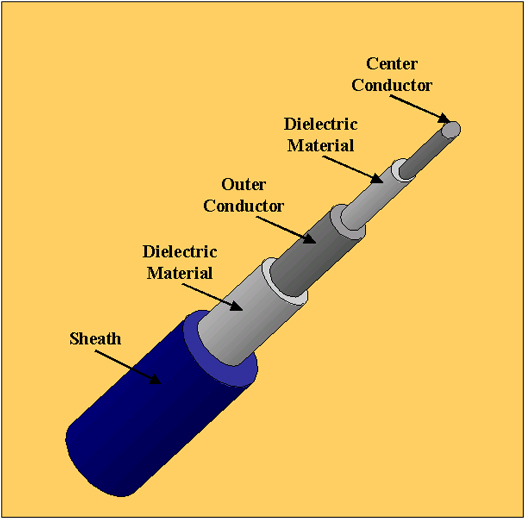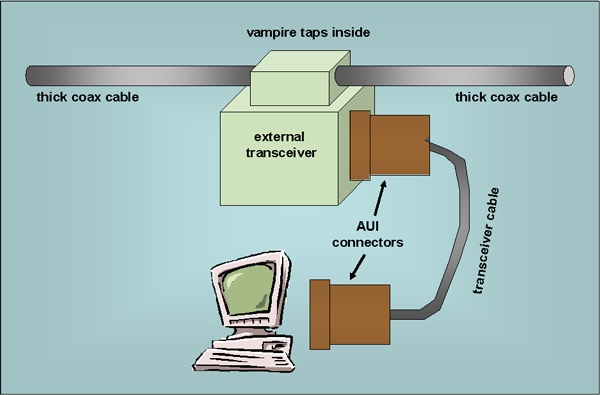
Ethernet
| Introduction.
We have already discussed particular network architectures in an earlier
web page. But now that we have more background and concepts we will
spend some time reviewing the main types of LAN architectures. This
page will focus on Ethernet. Ethernet. Ethernet was first developed at Xerox in the 1960s. After this a consortium was formed along with Digital Equipment Company and Intel to create the DIX Ethernet. Currently, Ethernet LANs are by far the most widely implemented type of LAN. This has essentially led to the IEEE 802.3 specifications. Ethernet networks are usually configured as a physical bus or star and use the CSMA/CD - Carrier Sense Multiple Access Collision Detection method of media access. They use baseband transmissions typically over coax, or twisted pair cable. Though they can be implemented through wireless media with somewhat different specifications which we will discuss in other webpages. Ethernets typically come in three main varieties based on their capacity. The standard is
There are different subcategories of Ethernet mostly based on the cabling that is used. The following list outlines some of the most prevalent.
The following sections give another survey of the characteristics of Ethernet networks based each of these types of cabling. Coax Based Ethernets Coaxial cable, usually referred to as coax, is named because it has two concentric conductors separated by insulation. The two conductors have the same axis. While the use of coax cable is pretty much passé, I present it for reference purposes. The following diagram illustrates the standard configuration. |

| 10Base2 Networks.
These networks implement the CSMA/CD access method in a linear bus
topology. Its specifications are presented in IEEE 802.3. The
cabling is a thin form of coax and is thus called
thinnet. The 10Base2 refers to the speed of the Ethernet and its maximum segment length. The 10 refers to the 10 Mbps speed. The 2 is a round off and indicates the maximum segment length of 185 meters. This network is limited to 30 nodes per 185 meter segment. Thinnet uses barrel connectors and T- connectors, both of which are called BNC connectors. They also require BNC type terminators on ends of the cable. The following diagram represents a BNC connector. |

| In general, 10Base2 was considered easy to install and
configure relative to its competition at the time. Its cable costs less per foot
than 10Base5 and it uses less cable than 10BaseT. It doesn't require
any extra components such as hubs or external transceivers. It was
generally considered to be useful for small temporary networks that needed
to be set up and torn down fairly regularly. Unfortunately, 10Base2 isn't very useful for larger configurations due to the limitations on segment lengths and the number of nodes per segment. In addition, the 10 Mbps is slow for more bandwidth intensive applications. 10Base5 Networks. These Ethernets use thick coax cable also called thicknet networks. This cable is approximately one half inch in diameter, about twice the thickness of thinnet. The 10 in 10Base5 derives to 10 Mbps speed. The 5 derives from the maximum length which is 500 meters. The minimum segment length is 2.5 meters. These networks are likely to be considered as standard Ethernet. One reason this cabling can be somewhat more difficult to work with than other connective devices because it is less flexible. It also the case that connections require what is called a vampire tap where a small hole is drilled into the cable to attach it to each connector. 10Base5 networks also make use of external transceivers to generate and receive the data signals. In almost all other Ethernet configurations the transceivers are built into the device NICs. 10Base5 makes use of AUI (DIX) 15-pin connectors with AUI cable to connect the transceiver to the NIC. |

|
Lengths of cable can be increased by using N-series barrels. Lines need to be terminated using N-series terminators. 10Base5 was often used as backbone to which thinnet is attached. Remember, it has a greater maximum spanning distance. For example, thinnet could be used on each floor of a building with a hub or repeater on each floor connected together using thicknet. Thicknet gives the following two major advantages over thinnet.
Thicknet also gives one sometimes worthwhile advantage over UTP
Some of the main difficulties associated with thicknet are given in the following bulleted list.
UTP Ethernet Networks The most popular cabling for Ethernets is UTP - Unshielded Twisted Pair. While there are many variants of UTP, most everyone is familiar with it because it is used for telephone cabling. UTP comes in different grades numbered as categories and summarized in the following table. Notice that almost all of these support faster transmission speeds than coax. UTP is also highly flexible and, relative to coax, easy to install. It uses RJ connectors, which are the modular plug types used for telephones. Most telephone cables use an RJ-11 connector. Most Ethernet cables connect with a slightly larger RJ-45 connector.10BaseT Networks. This is popular for LANs of all sizes. It is probably the most popular implementation of Ethernet, though it has likely given way to those with greater bandwidth in many places. It makes use of the star bus topology. It can run on Cat 3 cable which is already installed in most buildings for telephone communications. Newer 10BaseT networks are usually set up using category 5 cabling so that it is easy to upgrade to 100 Mbps later. These sorts of networks are inexpensive relative to other networking options. Although you need a hub if you are connecting two or more computers to create the core of the star. Fortunately, very inexpensive hubs can be found nowadays, but the additional cost may make such a network slightly more expensive than a thinnet network. Unfortunately, the maximum length for a cable segment is 100 meters. The UTP used in 10BaseT networks can be quite vulnerable to EMI radiation and attenuation. 100BaseX Networks. 100BaseX refers to Ethernet networks running at 100 Mbps over
Networks operating at these speeds are usually called Fast Ethernet. These networks use the same topology and access methods as 10BaseT. In fact, the only real differences are the they require a faster network card and hubs or switches that support the 100 Mbps transmission speed. Many hubs/switches and NICs support both 10 Mbps and 100 Mbps transmission speeds making it much easier to upgrade later. You can even run some LAN segments at 10 Mbps and others at 100 Mbps as you upgrade. Unfortunately, the UTP used in 100BaseT networks can be quite vulnerable to EMI radiation and attenuation. Hubs and switches for the faster speed are almost always somewhat more expensive than they are for the 10 Mbps networks. Fiber optic is the most expensive option both due to increased equipment costs and skill levels involved in installations. 1000BaseT Networks. This is more commonly called Gigabit Ethernet. It was established in 1996 as the IEEE 802.3x specifications. These provide for the speed, the Ethernet frame format and the CSMA/CD transmission method. Fortunately, Gigabit Ethernet has been developed to be interoperable and backward compatible with its predecessors. It can make an excellent backbone technology with 10BaseT and 100BaseT LANs. It can also be implemented over fiber optic cabling. Unfortunately, NICs, hubs and switches that support Gigabit Ethernet are several times more expensive than their predecessors. |